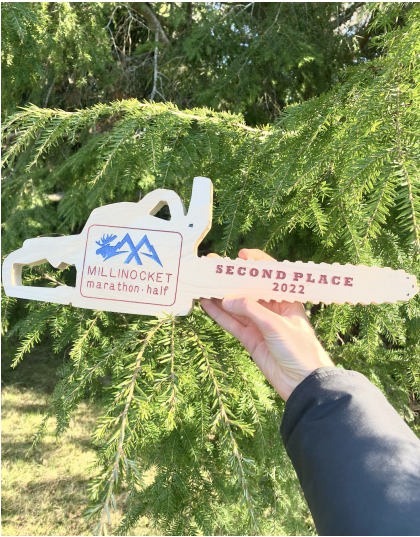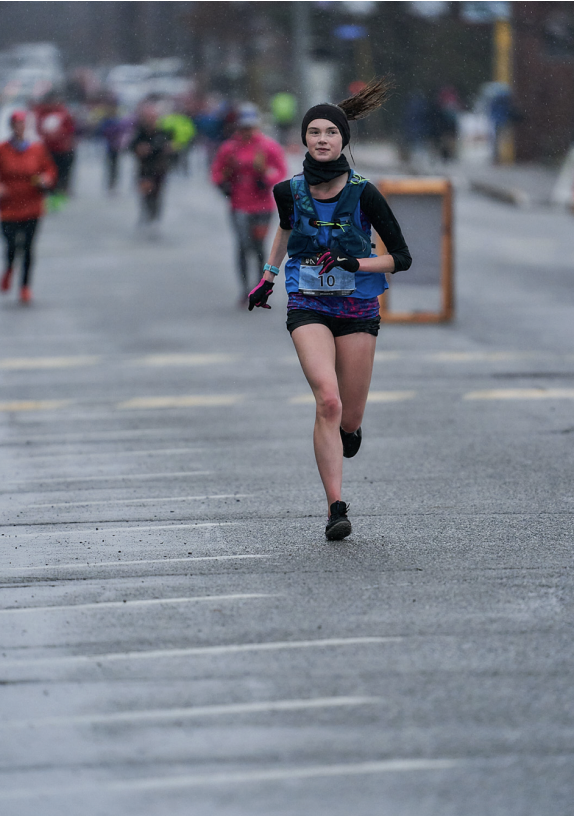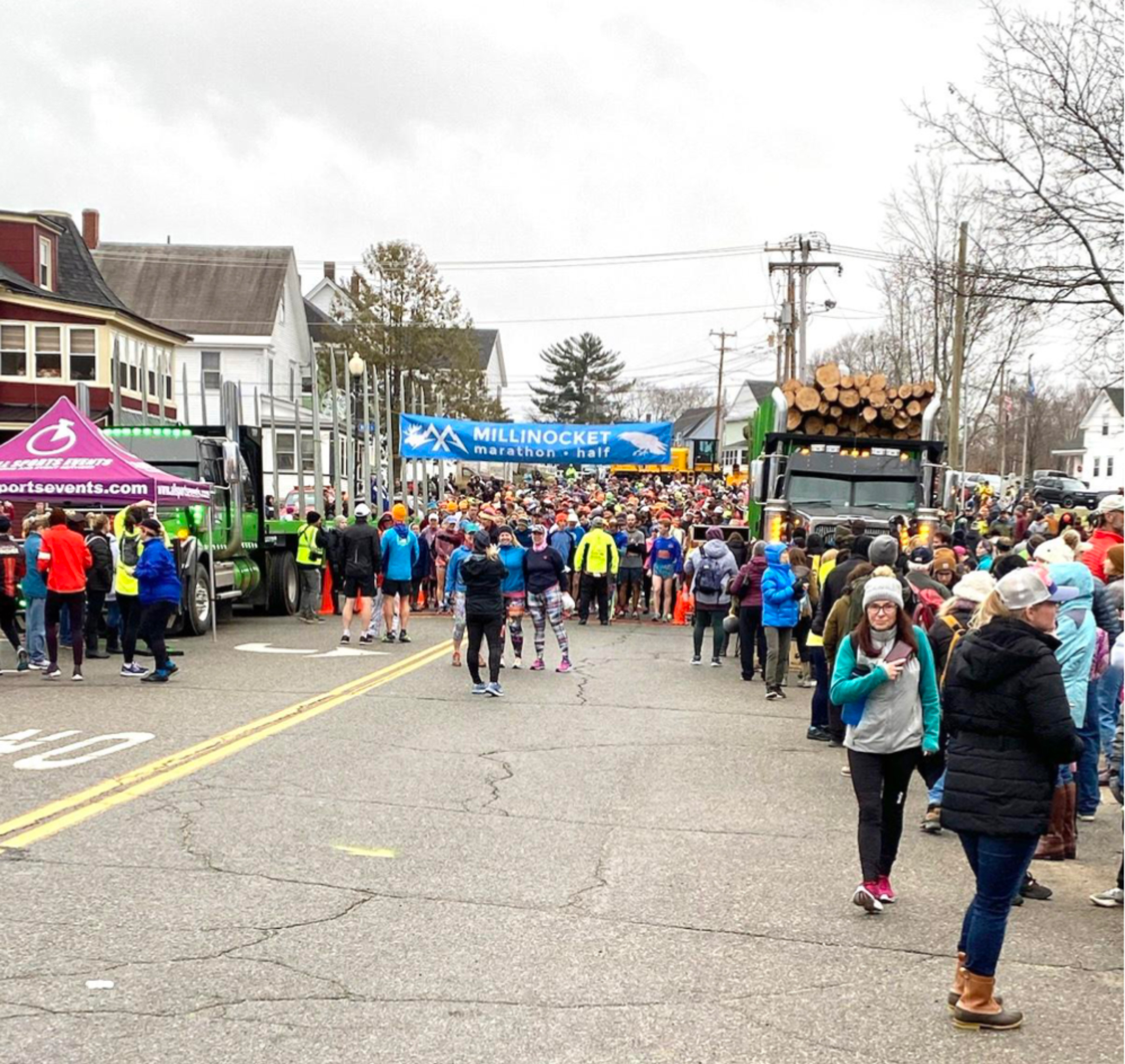PC: Tom Gaudrault
Once a thoroughfare for loggers making the trip to Quebec from the bustling mill town of Millinocket, Maine, the nearly 100-mile Golden Road stretches through the region’s heavily forested wilderness, providing stunning views of Mt. Katahdin along the way. But today, 14 years after the closing of the town’s paper mill, the Golden Road serves a much different purpose. Each December, when the region is typically blanketed with snow and average high temperatures dip well below freezing, over 2,000 athletes convene, hailing from nearly every state and outside of the country, to run a marathon.
For most, however, running is the secondary purpose of the event. The true reason for venturing to northern Maine in the middle of winter is to experience and support the local community. Race director Gary Allen, who founded the Millinocket Marathon in 2015, did so with the goal of bolstering a struggling mill town. In that first year, there was no official race, just a group of 52 runners meeting up to traverse one or two loops around the Golden Road, carrying laminated cards with handwritten, turn-by-turn directions. They stayed in town, did their holiday shopping at local businesses, and tipped extra when they went out to eat. Today, even as the event has exploded in popularity, its philosophy remains the same. There is no fee to enter the race. Instead, participants are simply encouraged to come and spend money in the town. Since the race’s beginning, well over $2 million has been brought into the community, with thousands of dollars donated to a handful of local organizations each year.
I was introduced to Millinocket early in my running career. Most runners are asked if they’ve run the Boston Marathon. Living in Maine, that question is replaced with Millinocket. Few events have such allure. There is the fireball whisky and organic maple syrup shots served at makeshift aid stations along the route, the course’s tough, unforgiving terrain (including an infamous 6-mile long hill), and, of course, the runners and town members who make it all possible. So after a busy 2022 of racing on the roads, trails, and mountains, I decided that Millinocket would be the perfect way to finish my season. I quickly learned that the event is far more than just a road race. There is the artisan craft fair where locally made gifts can be found for everyone on a Christmas list; the race morning breakfast hosted by a local snowmobile club; the “Millinock-Yourself-Out” comedy show following the run. There is even an informal 2k race, held the night before the marathon, where participants run through the dark streets of town in costume. And, of course, there is the overarching goal of community benefit and support, which manifests itself in every aspect of the event.



Race morning dawned unseasonably warm in temperature, but accompanied by a cold rain and wind. Sections of the dirt road were slick, with one quarter mile stretch completely covered by a thick glaze of ice. These somewhat miserable conditions, while undoubtedly warmer than usual, were perfect for Millinocket. This is, after all, not the kind of event where ‘comfortable’ is expected or hoped for. I opted to run by feel, not looking at my watch and instead letting the relentlessly undulating terrain guide my effort. My nutrition strategy would also be simple. During long, hard efforts, I fuel primarily with UnTapped energy gels. The Maple and Salted Raspberry are my flavors of choice.
Somewhere in the middle of the first of the race’s two loops, the light drizzle shifted to a more steady rainfall, and I found my mood darkening along with the skies. My legs were heavy, my stride was unrelaxed and my breathing felt labored just 4 miles into the race. Not knowing my pace was both a blessing and a curse – I assumed that since I felt so poor, I must be running similarly. But when we finally crested the last hill back into town, I was surprised to see the clock reading 1:26, well ahead of pace. All of a sudden, with the help of enthusiastic crowds lining the road, I felt much better, charging up the course’s steepest hill back onto the Golden Road for the final time. That high lasted until mile 22, when the characteristic late-race fatigue set in. My calves seized up, my form no longer felt so smooth, and every step became a struggle.
Turning back onto the final stretch, the crowds were electric. I immediately thought of Gary Allen’s words the previous day at the press conference, when he called Millinocket the “Boston Marathon of the North Maine Woods.” He was right, I realized. When the entire town comes out to support you, it’s impossible not to be bolstered by their energy. It’s even more special when the support goes both ways.
I crossed the line in 2nd place, running 2:58:15, and was ecstatic to break the 3 hour barrier on the infamous course. You don’t come to Millinocket to run a personal best. In fact, winners Sarah Mulcahy (2:57:33) and Matt Cheney, who set a course record of 2:36:21, both have run marathons over 12 minutes faster than their finishing times in this race. In Millinocket, it isn’t the time that matters, or even the place. What makes this event so memorable is the way that both the runners and the people of Millinocket go out of their way to support one another. The town comes together to create a magical weekend that truly rivals any big-city marathon. I have no doubt that it will continue to grow, and I can’t wait for another run on the Golden Road. Maybe next year the clouds will break and we’ll even get to see Katahdin. Either way, the runners will come, undeterred by whatever elements are thrown at them, eager to experience the community that makes our sport so unique and beautiful.
